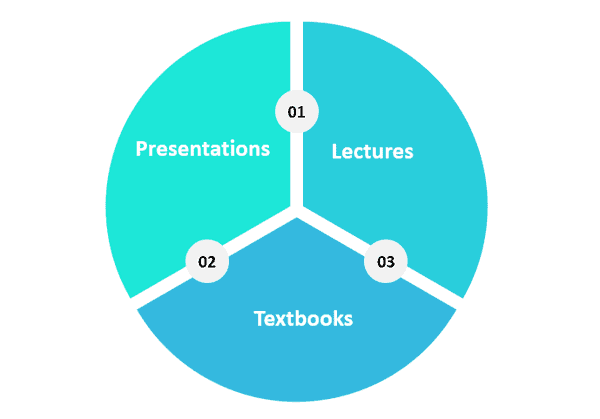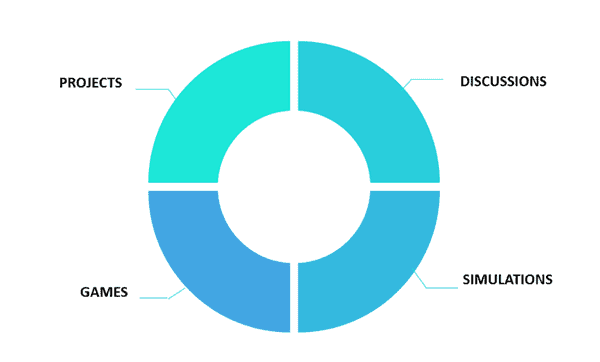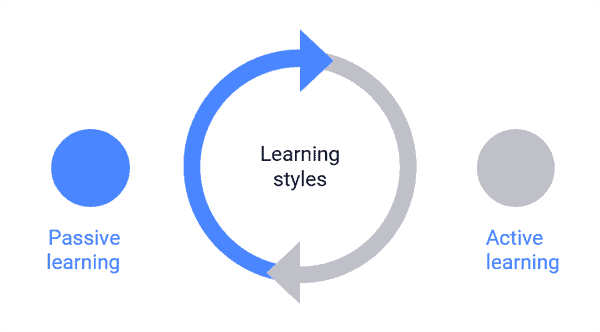Our content is reader supported, which means when you buy from links you click on, we may earn a commission.
How to Keep Your eLearning Courses From Falling into the Passive Learning Trap

As a course creator, what is your worst nightmare? Bad reviews? No one enrolling?
You must’ve thought, “What am I doing wrong?” I’ve covered all the course material, the curriculum is in demand, and I’ve compiled all the resources coherently.
You need to take a step back and look at the feedback you’re getting. When you look at your training videos, you won’t find any flaws because you yourself are the creator. You know how the eLearning course progresses and know what to expect.
But looking at it from the perspective of the learner, you may find that the course is not engaging. It’s a hard pill to swallow, but improvement comes with acceptance.
If your students practically fall asleep during your videos and gain no substantial knowledge from the material, the chances are that you’ve fallen into the passive learning trap. That’s when the learner becomes so disengaged that their focus diverges.
As a course creator, you want to avoid this situation at all costs. It’s a waste of time for your learner and for you. As someone who wants to bring about a transformative change in your students, you need to focus more on active modes of imparting education.
Here we compare active vs. passive learning, define what they are, and seek to answer the effectiveness of active learning.
What is Passive Learning?
Passive learning is one of the conventional modes of delivering education. As you’ll remember from your schooling years, it’s mostly a one-way street where the lecturer or professor delivers the learning material. It then puts the onus on the learner to dig deeper and figure out the intricacies of what they’ve learned.
This form is teaching is nothing new but can be traced back to the ancient Greeks – philosophers like Aristotle, whose Lyceum was an instrumental school of thought, or Plato’s Academies that built upon the thought process of Socrates. But, they too were havens for the exchange of thought, something that passive modes of learning often forego.
In eLearning platforms, this becomes more and more obvious. Churning out training videos leaves little to no room for discussion. Students have to settle for what they’ve received, even if they’ve absorbed only a smidge of the whole curriculum.
Examples of Passive Learning
It is not to say that passive learning is a completely unreliable form of teaching. Some students are particularly adept at passive learning. Perhaps, that’s due to their inclination to study independently. They may also have an innate curious nature or their ability to focus on the matter. Let’s explore some of the most common teaching modes these kinds of students are used to.

Lectures
In the case of eLearning, we’re referring to online lectures; however, both operate via the same means. The lecturer begins the class by outlining the topic, explains what it entails, and provides facts to support an argument.
Good lectures have one thing in common – they are coherent. That means they have a previously outlined structure that the lecturer follows and, explicitly or implicitly, covers the objectives of the curriculum from the information provided. However, what makes them ineffective at conveying information is their length.
If a student drifts off during an online lecture, they’ll have to go back to where they left off. In a classroom setting, this can’t be done. However, in online lectures, you may miss out on the atmosphere of a discussion that helps keep students engaged.
Additionally, the lecturer needs to include a fitting conclusion to the information conveyed during the lecture. This entails leaving students with a question to ponder over, leading them to supplementary reading material, or guiding them towards practice problems to sharpen their knowledge on the subject matter. In either case, trust is placed on them to gain knowledge in their own time.
Textbooks
Textbooks are the most common teaching instruments. Any course, whether eLearning or physical, recommends some textbooks for gaining information. It is more common for teachers to prescribe multiple textbooks that enhance students’ knowledge on the subject matter; however, they will use at least one of them as the primary one to cover the learning points of the course.
There are certain advantages to using textbooks, but these days, their disadvantages carry more weight. Textbooks compile the information into a single source of information, but it limits the course, preventing students from exploring more outside the textbook.
More importantly, textbooks are expensive. Most students won’t be able to support their education without them and may even get reprimanded for not purchasing them.
Perhaps the biggest drawback of textbooks in terms of passive learning is that it relies on the comprehension capabilities of the learner. Students normally don’t make an effort to hone their comprehension skills before going deeper into the text as it entails more time spent reading when they otherwise do something else. As a result, many students get distracted, demotivated, or worse, look for shortcuts that aren’t recommended.
Presentations
Sometimes teachers demand that their students present on the topics they’ve covered during the course. But 9 times out of 10, they are ineffective at fulfilling their objective. That is, teaching as a way to learn and improve one’s presentation skills. It becomes more of an assessment tool for the teacher instead of inculcating knowledge in students’ minds.
Like textbooks, the problem with presentations is again that it relies on the learning capabilities of the student. Again, it’s the student’s choice to include what they’ve learned, which may be nothing substantial at all. It’s a chance for them to showcase their creative skills; however, many students prefer to beautify their presentations rather than exhibiting a level of critical thinking. Sure, it will help them convey their ideas better, but what’s the point if their underlying axioms are flawed?
Building up on this, presentations may have a negative impact on their education if students positively correlate presentation skills with learning. What this means is that as long as they know how to sell their ideas, they’ll get by and don’t need to focus on the quality and credibility of the material presented.
Since all learners are different, have different rates at which they assimilate to learning, or are visual learners, an eLearning course has to cater to all of them. It is understandable that the multitude of topics prevents you from exploring active avenues, and so you have to rely on summarizing topics instead.
However, the learner today gets distracted and demotivated easily. To truly set your eLearning course apart, you have to put in the extra effort. The concept is best illustrated in the cone of learning.
The Cone of Learning
The cone of learning is an idea put forward by a prominent educator in the ‘40s and ‘50s, Edgar Dale. Dale questioned the conventional teaching modalities of educational institutes. At about the same time, a revolutionary change happened in audio-visual technologies, namely the television and radio.

Dale devised a pyramid that outlined the migration from passive to active learning, stressing the importance of formulating an educational experience that included audio-visual means of teaching. He outlined different teaching modalities that were further built upon researchers to the modern pyramid we have today.
The modes in descending order are as follows:
- Reading Text
- Hearing Instructions
- Watching Images
- Watching a video
- Viewing an exhibit
- Watching live instructions
- Hands-on workshops
- Role-play scenarios
- Simulating Real-Life Experience/Application
- Performing Relevant Task
As you go down this list, Dale claims that students are better able to grasp concepts because you shift from a passive mode of teaching to an active one. One where the student is actively taking charge of their education. The modern pyramid even includes percentages that define the level of retentiveness that can be achieved from each level, indicating the effectiveness of the module of teaching. However, it should be noted that the factual basis for these percentages cannot be determined as no supporting evidence points towards it.
It is, however, established that active forms of teaching are more beneficial to students than passive ones. When both are used together, one can utilize the different aspects of teaching much more effectively.
What Exactly is Active Learning?
As its name implies, active learning demands more participation from the students. It’s not just an instruction enforced upon students; instead, it involves coming up with methods that leave students with no other choice but to participate in the class environment.
Active learning is most beneficial when teachers need to cover topics of a complex nature. These include those topics that come in at a later stage of your eLearning course. Those that build up upon the supporting knowledge imparted during the initial stages of the course.
As an example, we’ll consider a topic of Mathematics – differentiation. It requires students to initially get an understanding of limits, but prior to this, they need to understand how functions are represented in a 2-dimensional plane. Even before, that they need to understand number systems. As you can see, in order to teach differentiation, you’ll need to cover some topics that have varying degrees of difficulty.
To explain how you can go about incorporating engaging methodologies of teaching calculus in an engaging way, we’ll look at some of the examples of active learning.
Examples of Active Learning
We’ll explain why each of these examples is suitable for creating a course outline for each teaching level, from beginner to advanced.

Discussions
When working towards teaching calculus, you need to start by defining the underlying axioms of mathematics that highlight the vocabulary that’ll be used and form the basis for future learning. The number system is an important concept when teaching mathematics as it showcases the different types of numbers and their properties.
Employing a passive learning regime is sufficient at this level; however, students can benefit more from a hands-on discussion on the topic. It can encourage them to clarify any misconceptions at this point so that they don’t face any roadblocks when moving onto intermediary level topics.
Simulations
A precursor to calculus is getting students familiar with how information is represented in mathematics. Most students at this intermediary stage are introduced to variables instead of numbers so that mathematical concepts can be more generalized. At this point in time, getting them familiar with graphing techniques is important so that they can form a mental map of the information presented to them and analyze how two seemingly related variables depend on each other.
Instead of just drawing a graph and summarizing its workings in a lecture, a student shows more understanding when a simulation is presented to them. Using software like Matlab or even MS Excelexhibits a much more clean representation of information and how different values change based on the other. As an exercise, you can encourage students to try out different simulations on their own as a practice to enhance their visual capabilities.
Games
Incentivized learning is catching up the arena of eLearning as well as classrooms. More and more teachers are reaping its benefits by incorporating gamification techniques. It serves to promote healthy competition in students and gauges their thinking skills under stressful situations.
Sticking to our calculus example, this strategy may come in handy when solving functions – an intermediary to advanced-level topics in mathematics. Students can take turns, going head to head with each other to simplify functions, figure out the solutions for two related functions, or draw them out. Incentivizing this whole experience with a prize can improve their drive towards learning and give them the insight to do better when they make a mistake.
Projects
Most students, when learning calculus, don’t know about its origins, historical background, and the mathematical foundations they had to go through before coming up with the idea. Plus, innovations don’t immediately lead to applications. Such is the case of calculus. Its discovery solved lingering puzzles in mathematics, provided elegant explanations to a physical phenomenon, and paved the way for future discoveries.
The implications of the discovery of calculus can be incorporated in a project, whereby students are tasked with coming up with a thesis that encompasses the implications of calculus’s discovery. For example, planetary motion, maxima minima, or derivations to mathematical puzzles that plagued the world of mathematics for millennia. It’ll help them realize the practical world applications for what they’re learning and give them insight into why it’s important to learn calculus.
Differences between Active vs. Passive Learning?
Both modes of learning have their fair share of pros and cons. Which methodology of teaching you use depends on the learning outcomes you want.

Passive Learning
At a basic level, passive learning is more than enough when introducing a course, outlining its learning points, and summarizing the key takeaways. There’s not much you can do here. You just need to explain things in the most rudimentary manner as you’re simply stating facts.
This helps to give an overview of the eLearning course, allowing students to stay informed of what they’re getting into and whether they’ll be able to gain substance from it.
The benefit of passive learning is that its evaluation methods are fixed. You teach a topic and make students go through a test or quiz, gauging their performance easily. However, active modes of learning are much more subjective and take into account a student’s prior knowledge, deficiencies, and creativity.
Hence, a definitive rubric is hard to come by. It mostly depends on the teacher’s own opinion of the student’s performance. This is beneficial for students who are still struggling with certain concepts but improving.
Active Learning
Active learning is more suited for the meat of what you’re trying to teach. You may have past experience teaching a particular subject or course. As a result, you’ll have some idea of the common problems areas for students. This gives you an opportunity to explore creative ways of imparting a particular topic or concept via the means described above.
Active learning is centered on a more independent form of learning. Students are put into situations where they are free to explore avenues; hence the knowledge they gain is only limited by their own capabilities. But, the element of independence lets them a chance to communicate and organize their thoughts in their own way, personalizing the learning experience.
Passive learning, on the other hand, is pretty one-way. The teacher governs the level of communication. A good teacher will entertain queries and initiate discussions, but that’s pretty much all they can do.
Is Passive Learning Effective?
Both passive and active learning work better in certain situations. It’s perfectly alright to have passive learning activities. In fact, it is recommended so that students can take a break from all the activities and assimilate to what they’ve learned.
Plus, students need to solve practice problems. It is the only way for them to improve their approach to solving math problems. They need to read more in order to improve their focus and comprehension skills.
Incorporating both will get you the best results. You can include a small game between reading sessions, play out a video that visualizes concepts, or have a build your own flashcards activity. The point here is collaboration. You want students to remain engaged in the session every time you think they’re drifting away. Moreover, the sharing of knowledge that happens in a community is much more insightful than learning individually.